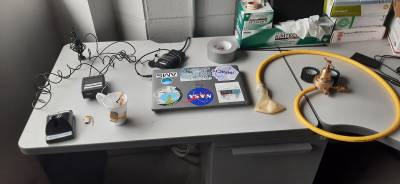Table of Contents
Mini Sonde
Summary
- Manufacturer: Windsond
- Receiver Serial Number: BP 02989
Sample Launches
Overview
The mini sonde by Windsond consists of a styrofoam cup with light instrumentation onboard. It is trackable by GPS on Google Earth, has a mass of about 16 grams, and can be launched from a much smaller balloon than a normal sonde, allowing for easier deployment and a more economical refilling of balloons. These sondes are also reusable. There are two versions, a single balloon and a two balloon (known as Swarmsonde) system.
The radio communication between USB receiver and sonde uses the 434 MHz radio band, with 100 mW effect. The exact frequency is configurable at run-time in the range 400-479.9 MHz. The transmission power can also be lowered to follow local radio regulations. For safety, before launch check that the software reports a solid radio link by a green radio sub-system panel on the status tab. When the sonde starts, it looks for the receiver at the last known frequency for 5 seconds. If the receiver is not found, the sonde starts alternating between a pre-defined frequency (434.00 MHz) and the last known frequency. At first start of a new sonde or to make the sonde recognize a new frequency, press the software button “Pair with sonde” until a window appears for the sonde.
Equipment
The Mini-sonde system is made up of three main components.
- Sonde/Battery/Charger
- Receiver/Computer/Cable
- Balloon/Regulator/Tubing-FillingHead
The last item is to have a tank of helium. We have used the Radiosonde S1H3-R-SW Swarmsonde and Radiosonde S1H3-R. We been using the Argon, Helium, Nitrogen, Gas Regulator, CGA-580, Single Stage, Brass, 0 to 125 psi available at https://www.grainger.com/product/HARRIS-Argon-5KZ46
How to Set up Software
There are two version of software to used. Regular sonde software - https://windsond.com/windsond_2.109_setup.exe and Swarmsonde software: https://windsond.com/windsond_2.106_16sondes_setup.exe
The software requires a license file to run. License file is on the ballooning laptop in the garage and will also soon be copied to the NAS drive. Both types of sondes also require Google Earth in order to track properly.
On the desktop of the computer I recommend having the Google Earth file for the sonde (it is a .kml file, check the manuals on the NAS drive for the name of the file) and the data readout program in a file and have the file named Windsond.
Data Output
In addition to the WindSond and Google Earth data outputs, there exists numerous other data formats for which the WindSond program can additionally produce. To enable these formats, perform the following procedure before turning on the radiosondes:
- Startup the WindSond program
- Click “File” → “Settings”
- Scroll down and find “Generated File Formats”
- Enable the desired formats.
Some relevant file formats include CSVs, SHARPpy.txt files, WRF-related files, etc. It is recommended once the radiosondes are turned on, to check within the designated data output folder and verify these file types are being recorded.
If the file formats enabled were found to be the incorrect types after launch and/or the desired format was not enabled upon launch, simply:
- Startup the WindSond program
- Click “File” → “Settings”
- Check/Enable the “Generate output files in replay” box.
- Scroll down and find “Generated File Formats”
- Enable the desired formats.
- Exit settings by clicking “OK”
Now open the desired sounding file and check the output directory. The newly enabled data formats should appear.
Inventory
WindSond Toolbox: (As of 04/29/2024)
- Windsond RR2 Receiver
- Laptop Charge Cable / 90W-AC Adapter
- Computer charging block (PK0BM)
- Car to charging block chord
- 2 Antennas
- Receiver → USB cable
- Rechargeable battery USB cord (Currently Missing)
- String and Rectangular Cardboard Cutouts (In Bag)
- Large charged reusable batteries (in bag) X3
- Small charged reusable batteries (in bag) X17
- Small uncharged reusable batteries (In Bag) X0
- Total small batteries x17
- Total large batteries x3
- 2 Spare Antennas and Spare Mounting Pieces (In Bag)
- Yellow Tape as Single Minisonde Approximate Weight
- 12“ 40lb Black Zip Ties (In Bag)
- Red/Black Striped Rope
- 2 Bags of Balloons
- USB Li-Po charger (likely not working)
- Various Paper Documents:
- 2 Lithium Polymer Battery Instruction Manuals (Within holders)
- Windsond Letter of Warranty
- 2 Antenna Mounting Guides
Windsond Radiosondes: (As of 04/05/2022, Times indicate how long to connect to GPS signal as of 05/26/2022)
- Tested and Working:
- Swarmsondes: 6103 (2.25 mins), 6104 (3 mins), 6105 (20 seconds), 6106 (2.75 mins), 6111 (2.5 mins), 6112 (1.75 mins)
- Minisondes: 6761, 6762, 6763, 6764, 6765, 7222, 7223, 7224, 7225
- Needs Testing and Restringing:
- Swarmsondes: N/A
- Minisondes: N/A
- Not Working:
- Swarmsondes: N/A
- Minisondes: N/A
Additional Information
For additional information on any of the mini sondes, please check the Windsond file on the NAS drive.
====Setting up a Minisonde Project====|
| Item | Cost | Link to Purchase | |
|---|---|---|---|
| Heading 3 | Row 1 Col 2 | Row 1 Col 3 | |
| Heading 4 | no colspan this time | ||
| Heading 5 | Row 2 Col 2 | Row 2 Col 3 |
